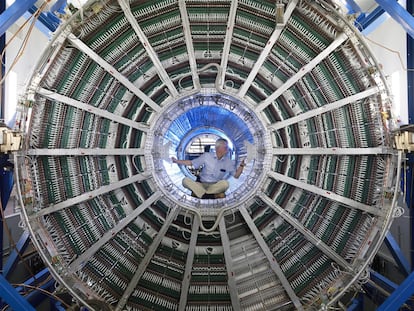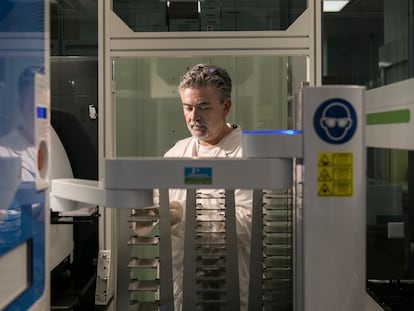CERN’s Large Hadron Collider, the biggest experiment on Earth, is back in action
The Geneva-based accelerator has just discovered three new particles after being fired up again following a three-year hiatus

Thousands of protons, accelerated almost to the speed of light, collided recently at an energy level never before achieved by a particle accelerator. The Large Hadron Collider (LHC), which tries to answer some of the fundamental questions about the universe, is functioning again after a three-year hiatus, and it has already delivered: on Tuesday, the European Organization for Nuclear Research (CERN), which runs the facility, announced the discovery of “three never-before-seen particles: a new kind of pentaquark and the first-ever pair of tetraquarks. They will help physicists better understand how quarks bind together into these composite particles.”
The LHC is the largest experiment ever built on Earth. The inside of its 27-kilometer (17 mile) underground ring, located beneath the French-Swiss border near Geneva, emulates the conditions that existed fractions of a second after the Big Bang, the explosion that created the universe 13.7 billion years ago. At that time there were no atoms, only their indivisible components: elementary particles. There are still many questions about what made elementary particles bind together, forming a universe with stars, galaxies and habitable planets, instead of annihilating themselves in a clash between matter and antimatter.
The machine was shut down in 2019 for maintenance and upgrades. In 2021, the process of restarting it for its third round of experiments began, and it officially inaugurated its round 3 season on Tuesday. The LHC will operate without interruption for almost four years, taking scientific data on particles at a record energy of 13.6 teraelectronvolts. The number of collisions, disintegrations and other subatomic interactions will be 20 times greater than during the first round, which culminated in the discovery of the Higgs boson particle just 10 years ago.
One of the main objectives of the LHC in this new stage will be to generate millions of Higgs bosons. Without this particle, the universe as we know it could not exist: it gives its mass to other elementary particles when interacting with them. The theory of the Standard Model, formulated in the 1970s, provides the exact value of each of these interactions. Any deviation between theory and what is observed at the LHC can reveal hitherto unknown mechanisms, forces or particles of nature. “We have to get the most precise X-ray of the Higgs boson that has ever been done in order to confirm that it behaves as we expect,” explains Mario Martínez, a physicist at Atlas, one of the LHC’s large detectors.
Last April, a US experiment announced one of the largest anomalies recorded to date: the mass of the W boson is not what theory predicts. The previous year, the LHC and another laboratory in the US also observed discrepancies in the behavior of the muon, another elementary particle. The LHC is likely to be able to measure the characteristics of these particles more precisely and deliver a final verdict on “new physics.” If so, it would be a much more important discovery than that of the Higgs boson. The new discovery could begin to explain what comprises the 95% of the universe that is made up of dark matter and dark energy.
The theory that describes the behavior of conventional matter includes 17 types of elementary particles that appeared moments after the Big Bang in three successive generations, each one with more mass than the previous one. The increase in energy at the LHC - up from 13 teraelectronvolts to the current 13.6 - will make it possible to study for the first time the decomposition of the Higgs into second-generation particles, such as muons. “The differences in mass between the different generations of elementary particles are enormous, and we don’t know why,” explains Alberto Casas, a researcher at the Institute of Theoretical Physics in Madrid. “There are very strong reasons to think that there is a new physics and a theory superior to the current one to explain it. For the first time, the LHC is going to be able to search for it in unexplored energy levels,” he adds.
Casas is an expert on the problem of dark matter, which makes up 27% of the cosmos. Although it is invisible, physicists are convinced of its existence because they observe it indirectly, through forces including the gravity it exerts on stars and galaxies. So far, no experiment has been able to detect it directly. “Physicists know very well what dark matter is not, but we have no idea what it is. Among all the experiments that try to study it, the LHC is the only one that could generate dark matter particles,” explains Casas.
The LHC’s great asset is its ability to create a large number of collisions between protons, which then decompose into elementary particles, and obtain results on their masses with high statistical reliability. In the “intermediate” phase that began on Tuesday, the main task will be to make high-precision measurements of the Higgs boson and the rest of the particles, as explained by Alberto Ruiz from the Physics Institute of Cantabria, in northern Spain. “Once this phase is finished, the LHC will stop to improve its detectors and further increase the number of collisions it produces,” he details. In 2029 the accelerator will start functioning again, and will generate 10 times as much data as what is known so far. Until then, Ruiz concludes, the possibility of discovering “new physics” is ongoing.
Tu suscripción se está usando en otro dispositivo
¿Quieres añadir otro usuario a tu suscripción?
Si continúas leyendo en este dispositivo, no se podrá leer en el otro.
FlechaTu suscripción se está usando en otro dispositivo y solo puedes acceder a EL PAÍS desde un dispositivo a la vez.
Si quieres compartir tu cuenta, cambia tu suscripción a la modalidad Premium, así podrás añadir otro usuario. Cada uno accederá con su propia cuenta de email, lo que os permitirá personalizar vuestra experiencia en EL PAÍS.
¿Tienes una suscripción de empresa? Accede aquí para contratar más cuentas.
En el caso de no saber quién está usando tu cuenta, te recomendamos cambiar tu contraseña aquí.
Si decides continuar compartiendo tu cuenta, este mensaje se mostrará en tu dispositivo y en el de la otra persona que está usando tu cuenta de forma indefinida, afectando a tu experiencia de lectura. Puedes consultar aquí los términos y condiciones de la suscripción digital.










































